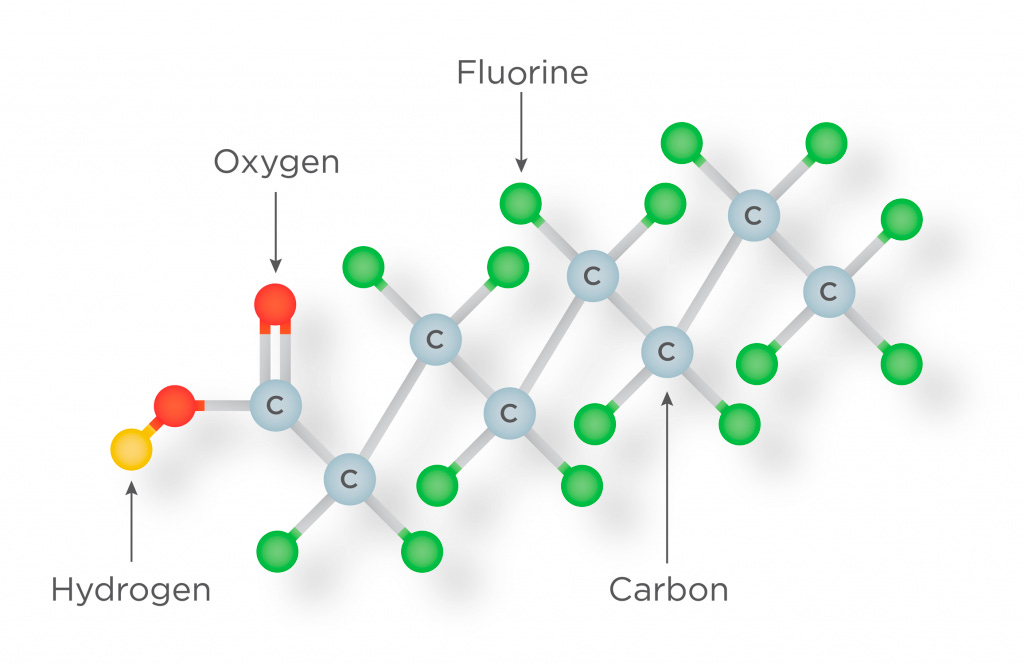PFAS (a type of forever chemical) are all around us – in water, food, dust, consumer products and more. Exposure to high levels of PFAS is a serious health hazard but the impact of low levels (that most people face) is unclear. PFAS pose the greatest threat to those who are highly exposed or are vulnerable because of their stage of life or health conditions.
PFAS (a type of forever chemical) are all around us – in water, food, dust, consumer products and more. Exposure to high levels of PFAS is a serious health hazard but the impact of low levels (that most people face) is unclear. PFAS pose the greatest threat to those who are highly exposed or are vulnerable because of their stage of life or health conditions.
What are PFAS?
PFAS (per and polyfluoroalkyl substances) are a family of man-made (synthetic) chemicals that are used industrially to create products that resist heat, water, and grease. They are used in firefighting foam, paint, and consumer products ranging from non-stick cookware (Teflon) to food packaging, waterproof makeup, water-resistant clothes, stain-resistant carpets, silky floss (Glide) and more.
PFAS are known as “forever chemicals” because they contain strong bonds (between carbon and fluoride) that don’t break down easily – nature has not evolved a way to do this! As a result, PFAS persist for years in the environment and our bodies, and most of us have detectable PFAS in our blood (see US CDC data). The PFAS chemical family includes thousands of different members, each with unique effects. Two of the most common types of PFAS are PFOA and PFOS, which are largely banned but still persist in the environment. Other types of PFAS include PFNA, PFHxS, PFBS, and “Gen X.”

Note: PFAS are just one type of “forever chemical.” Other types of forever chemicals include PCBs (polychlorinated biphenyls) and DDT (dichloro-diphenyl-trichloroethane). These man-made chemicals don’t break down easily because there is no natural pathway to do so.
What do we know – and not know – about the health effects of PFAS?
While PFAS have been used industrially for 70 years, their health effects have only been widely recognized in the last few decades. The first red flags came from people who were highly exposed – factory workers and towns where people were drinking contaminated water or eating beef that was contaminated (from cattle fed PFAS). We now have a large body of evidence, spanning hundreds of studies, showing that this family of chemicals can be a serious health hazard to humans and animals (see 2022 PFAS evidence map). A 2022 report by the US National Academies of Sciences, Engineering, and Medicine identified ten health risks (listed below) and noted that those at greatest risk include those with risk factors for these health effects and those who are in vulnerable life stages (pregnancy, fetal development, early childhood, and the elderly).
In the coming years, we will undoubtedly learn more in the coming years about the health effects of PFAS. It’s a daunting task given that thousands of different PFAS are out there.

Source: 2022 report from US National Academies of Sciences, Engineering, and Medicine. * = adults; ** = adults and children
Clearly, these chemicals deserve our attention. It’s not okay for workers and people in nearby communities to face unsafe chemical exposures, and consumers shouldn’t be left navigating this complex landscape on their own. Slowly but surely, governments around the world are taking steps in the right direction. For example, PFAS limits and testing are becoming integrated into drinking water systems around the world, and last month the US EPA instituted the first federal limit on PFAS in drinking water (sadly, years after many other countries). Much more action is needed – more research, more regulations, more monitoring, more innovation to remove PFAS and find safe alternatives (easier said than done!).
Note: The history of unraveling the health effects of PFAS is disturbing and highlights the need for tighter industry regulations. Documents that were made public in the 1990s show that companies making PFAS, notably DuPont and 3M, were aware of health hazards but kept it under wraps. They used tobacco industry tactics to delay awareness and regulations governing their use. Read more here.
The bottom line
The impact of PFAS on your health depends heavily on your level of exposure. For the average person with low exposure, the impact of PFAS on health pales in comparison to the heavy hitters: exercise, diet, sleep, stress, alcohol, smoking, and drugs. However, PFAS are a major concern for those who face high exposures (work exposure and/or living near contamination) or are vulnerable because of their stage of life or health risks. As they say, the dose (and context) makes the poison!
In short: don’t panic, but do educate yourself. Stay tuned for more information on PFAS exposure, water filters, testing, and more. If you can’t wait for the next post, dive into the resources below.
Those Nerdy Girls
Resources:
- Risk in perspective series (by SciMoms)
- PFAS exposure sources and reduction (by US National Academies of Science, Engineering and Medicine)
- PFAS safety (by Health Canada)
- PFAS explained (by EPA)
- PFAS occupational exposure (by National Institute for Occupational Safety & Health | NIOSH)
- PFAS and Your Health (by Agency for Toxic Substances and Disease Registry | ATSDR)
- PFAS overview (by NIH National Institute of Environmental Health Sciences)
Link to Original Substack Post


